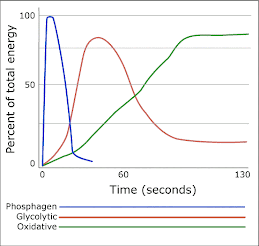There are three biochemical means in which energy is provided for all human action. They are phosphagen, glycolytic, and oxidative. In other words your body gets energy in three ways depending on the demands of the activity you are participating in. We call these energy sources metabolic pathways or energy pathways. Wether you realize it or not we have been training in all three.
The phosphagen pathway provides the bulk of energy used in high powered activities, those that last less than ten seconds.
The glycotic pathway provides energy for activities that last up to several minutes.
The oxidative pathway provides energy for low-powered activities, those that last in excess of several minutes.
There are a lot of complex process that go into energy production and we will skim across that in future blogs but, for this blog I want you to give me an example of an activity that we have done in class that trains each of the metabolic pathways listed above.
Great SEO Advice for CrossFit Gyms
4 years ago

13 comments:
During 5x5's we primarily use the phosphagen pathway. (Creatine is mostly used for this system because it replaces the phosphate to turn ADP into ATP which can be used by the muscle to produce force and allow more repetitions in a single set.)
We used the glycotic pathway during the fitness test of pushups. It took around 5 minutes so it may have started to use the oxidative pathway towards the end though.
During the mile run we used the oxidative pathway.
-Jack Corbett
speed and agility-brandon wong
Jack,
You are the man, even with a pink backpack.
The phosphagen pathway is used when we do the individual exercises in the 50 50s metcon. The whole metcon is using the oxidative pathway but the individual workouts like burpees, box jumps, dumbell swings, knees to elbows, and push ups are using the phosphagen pathway.
The oxidative pathway is also used during the mile.
The Glycotic pathway is used when we do the tabada run.
-Steven Rubin
In class, we used the phosphagen pathway to get energy when we did five repetitions for five sets of push press, dead lifts, bench press, squat, and other high powered short activities.
I used the glycotic pathway when attempting to do 100 box jumps.
We used the oxidative pathway when running the mile at a constant, medium pace for more than several minutes.
- Max Simon
We used the phosphagen pathway when we do try to max out one differnt lifts. So far the best example of phosphagen pathway however has been the 5*5 exercise.
We used the glycotic pathway when we do metcon/crossfitt doing non stop exercise until our time has expired.
We used the oxidative pathway when we run/jog the mile at a consistant speed.
-David Sureff
phosphagen- any heavy 5x5s ( bench press, push press, dead lift)
gylcolytic- pushups, box jumps, running
oxidative- walking, jogging
- mitch levy
Most of the lifts we do train the phosphagen pahtway. for example, a set of five on deadlift is a short powerful excersise that would exhaust the phosphagen energy system.
The glycotic energy system is used when we do excersises like push-ups, sit-ups, hollow-rock etc. These excersises last for about a minute or so, so therefore they use the glycotic energy system.
The oxidative system was used when we ran a mile because it was an excersise that took around 7 minutes and was ran at a certain pace.
Metcon excersises aim to train all three energy systems. It aims to train for power (phosphagen), Endurance (oxidative), as well as your ability to use both in conjunction (glycotic).
-Mike Barbaro
During deadlift we use the phosphagen pathway.
We used the glycotic pathway when we do box jumps and sit-ups.
We use the oxidative pathway when we do the mile.
Andrew Weinstein
we use the phosphagen pathway on our power lifting days that employ quick explosive movements as opposed to such activities as the 100 squats test which took a few minutes to compolete so it uses the glycotic pathway. the mile run and metcons such as the 20 minute cindy workout use oxidative pathway.
-Matt Scherer
We use the phosphagen pathway during heavy lifts with few reps.
We use teh glycotic pathway during workouts such as 21-15-9 thrusters/pullups
We use the oxidative pathway for long workouts such as the 200 yard,50 sit-ups,50 supermans that take a while
-conrad austen
Phosphagen is the energy pathway that is used in short exercises like 5x5 lifts. The glycotic pathway is used primarily during exercises such as 21-15-9 rep exercises. The oxidative pathway is used in long endurance exercises such as jogging and stuff
-conrad austen
Glycotic is when we do cindys.
When we run we use ocidative.
And when we do the tobada ifght gone bad workout we use the phosphagen workout.
Andrew Yi
Post a Comment